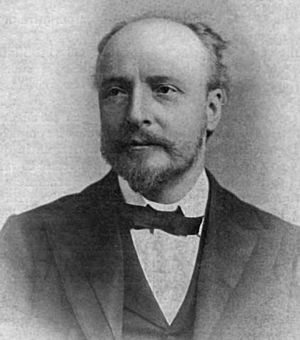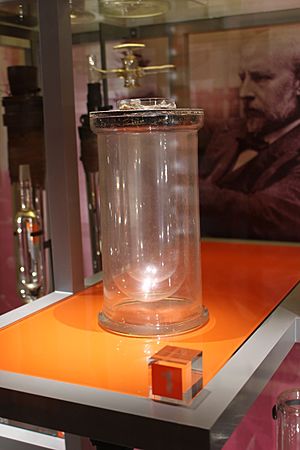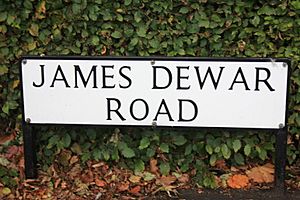James Dewar facts for kids
Quick facts for kids
Sir James Dewar
|
|
|---|---|

Sir James Dewar FRS
|
|
| Born | 20 September 1842 |
| Died | 27 March 1923 (aged 80) |
| Nationality | Scottish |
| Alma mater | University of Edinburgh |
| Known for | Liquid oxygen Liquid hydrogen |
| Awards | Hodgkins gold medal (Smithsonian Institution) Lavoisier Medal (French Academy of Sciences) Albert Medal (Royal Society of Arts) Rumford Medal (1894) Franklin Medal (1919) |
| Scientific career | |
| Fields | Physics Chemistry |
| Institutions | Royal Institution Peterhouse, Cambridge |
| Doctoral advisor | Lord Playfair |
Sir James Dewar (born September 20, 1842 – died March 27, 1923) was a brilliant Scottish chemist and physicist. He is most famous for inventing the vacuum flask, also known as a Thermos. He used this invention to help him turn gases into liquids. He also spent over 25 years studying how atoms and molecules interact with light, a field called spectroscopy.
Contents
Early Life and Education
James Dewar was born in Kincardine, Scotland, in 1842. He was the youngest of six boys. His parents passed away when he was 15 years old.
He went to Kincardine Parish School and then Dollar Academy. Later, he studied chemistry at the University of Edinburgh. There, he worked as a personal assistant to his teacher, Lyon Playfair. Dewar also studied at Ghent in Belgium.
A Busy Career in Science
In 1875, Dewar became a professor of natural experimental philosophy at the University of Cambridge. He also joined the Royal Institution in London. In 1877, he became a professor of chemistry there.
Dewar was also the President of the Chemical Society in 1897. He led the British Association for the Advancement of Science in 1902. He also helped examine London's water supply and worked on a committee about explosives.
Developing Cordite
While working on the explosives committee, Dewar teamed up with Frederick Augustus Abel. Together, they created cordite. This was a new type of smokeless gunpowder.
Early Scientific Discoveries
In 1867, Dewar described several chemical ideas for benzene. In 1869, he became a Fellow of the Royal Society of Edinburgh. His former teacher, Lyon Playfair, suggested him for this honor.
Dewar's early scientific work covered many different areas. He studied organic chemistry, hydrogen, and how hot things like the Sun and electric sparks were. He also looked at how light interacts with chemicals.
Working with Other Scientists
Dewar worked with Professor J. G. McKendrick from the University of Glasgow. They studied how light affects the body. They looked at how the retina in the eye changes when light hits it.
Starting in 1878, Dewar began a long series of studies with Professor G. D. Liveing. They used spectroscopy to examine different gases from the air. They cooled these gases to very low temperatures.
He also worked with Professor J. A. Fleming from University College London. They investigated how electricity behaved in substances that were cooled to very low temperatures.
Master of Cold: Liquefying Gases
Sir James Dewar is most famous for his work on turning gases into liquids. He also studied what happens to materials at temperatures very close to absolute zero. This is the coldest possible temperature.
His interest in this field began as early as 1874. In 1878, he showed how to use a special machine to liquefy gases. Six years later, he publicly showed how to turn oxygen and air into liquids.
Soon after, he built a machine that could produce liquid oxygen in large amounts. He used this liquid oxygen to study meteorites. Around the same time, he also managed to get oxygen into a solid state.
The Famous Vacuum Flask

By 1891, Dewar had built machinery at the Royal Institution that made liquid oxygen in huge quantities. Around 1892, he came up with the idea of using special containers with a vacuum layer to store liquid gases. This invention became known as the Dewar flask, or Thermos.
The vacuum flask was so good at keeping heat out that it could preserve liquids for a long time. This allowed scientists to study their properties. However, Dewar did not make money from his invention. He lost a court case against the company Thermos. Even though he was recognized as the inventor, he had not patented his idea.
Liquefying Hydrogen and Helium
Dewar then experimented with a high-pressure hydrogen jet. This helped him reach very low temperatures. In 1898, he successfully collected liquid hydrogen for the first time. Solid hydrogen followed in 1899.
He tried to liquefy the last remaining gas, helium. Helium turns into a liquid at an incredibly cold temperature of -268.9 °C. However, he was not the first to succeed. Heike Kamerlingh Onnes was the first to produce liquid helium in 1908. Onnes later won the Nobel Prize in Physics for his work. Dewar was nominated for the Nobel Prize several times but never won.
In 1905, Dewar began studying how charcoal absorbs gases when cooled. He used this research to create very strong vacuums. These vacuums were useful for new experiments in atomic physics. He continued his research on elements at low temperatures until World War I began.
After the war, Dewar's research changed. He focused more on studying surface tension in soap bubbles.
Family Life
James Dewar married Helen Rose Banks in 1871. They did not have any children.
Helen was the sister-in-law of two important people: Charles Dickson, Lord Dickson and James Douglas Hamilton Dickson.
Dewar's nephew, Dr. Thomas William Dewar, was an artist. He painted a portrait of Sir James Dewar.
Awards and Recognition
Even though he never won a Nobel Prize, Sir James Dewar received many honors. The Royal Society made him a Fellow in 1877. They also gave him several medals, including the Rumford (1894), Davy (1909), and Copley Medal (1916).
In 1899, he was the first person to receive the Hodgkins gold medal from the Smithsonian Institution in Washington, D.C. This was for his contributions to understanding air.
In 1904, he was the first British person to receive the Lavoisier Medal from the French Academy of Sciences. In 1906, he received the Matteucci Medal from the Italian Society of Sciences. He was knighted in 1904, which means he received the title "Sir."
In 1908, he was awarded the Albert Medal. A crater on the Moon was named in his honor. A street at the Kings Buildings complex of the University of Edinburgh was also named after him.
Images for kids
See also
 In Spanish: James Dewar para niños
In Spanish: James Dewar para niños





